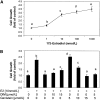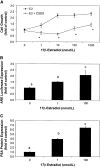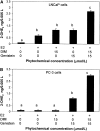3,3'-Diindolylmethane and genistein decrease the adverse effects of estrogen in LNCaP and PC-3 prostate cancer cells
- PMID: 19022961
- PMCID: PMC3415863
- DOI: 10.3945/jn.108.090993
3,3'-Diindolylmethane and genistein decrease the adverse effects of estrogen in LNCaP and PC-3 prostate cancer cells
Abstract
Evidence suggests that 17beta-estradiol (E2) contributes to the risk of prostate cancer (PCa), whereas the phytochemicals genistein from soy and 3,3'-diindolylmethane (DIM), derived from indole-3-carbinol in cruciferous vegetables, decrease the risk of PCa. This study examined the potential of these phytochemicals to reduce the adverse effects of E2 on PCa. In LNCaP PCa cells (E2 sensitive), DIM decreased E2-induced proliferation. Genistein increased proliferation at low concentrations and decreased proliferation at higher concentrations; DIM abolished the increased proliferation by genistein. The E2 stimulation in LNCaP cells was consistent with dependence on the androgen receptor, as evidenced by the inhibition of E2-induced proliferation with the antiandrogen casodex, E2 stimulation of an androgen response element luciferase reporter, and E2 stimulation of prostate-specific antigen (PSA) protein expression. Both genistein and DIM abrogated the E2 stimulation of PSA. Genistein and DIM altered major E2 metabolism pathways in LNCaP and PC-3 (E2 insensitive) PCa cells by increasing the expression of the 2-hydoxylation enzyme cytochrome P450 1A1 (CYP1A1) and the O-methylating enzyme catechol-o-methyltransferase (COMT) as determined by real-time RT-PCR. The increase in COMT mRNA occurred only when the combination of DIM and genistein (15 micromol/L) was used. Quantitation by MS indicated increased 2-hydroxyestrogen and decreased 16alpha-hydroxyestrone, a result that should result in less estrogenicity and increased amounts of the anticancer metabolite 2-methoxyestrone. We conclude that DIM and genistein decrease the effects of E2 that have the potential to promote PCa.
Figures





References
-
- Ho SM. Estrogens and anti-estrogens: key mediators of prostate carcinogenesis and new therapeutic candidates. J Cell Biochem. 2004;91:491–503. - PubMed
-
- Ellem SJ, Risbridger GP. Treating prostate cancer: a rational for targeting local oestrogens. Nat Rev Cancer. 2007;7:621–7. - PubMed
-
- Risbridger GP. Androgens vs estrogens in prostate cancer. Endrocrine Abstracts. 2003;5:S7.
-
- Griffiths K. Estrogens and prostatic disease. Prostate. 2000;45:87–100. - PubMed
-
- Steiner MS, Raghow S, Neubauer B. Selective estrogen receptor modulators for the chemoprevention of prostate cancer. Urology. 2001;57:68–72. - PubMed
Publication types
MeSH terms
Substances
Grants and funding
LinkOut - more resources
Full Text Sources
Medical
Research Materials
Miscellaneous

